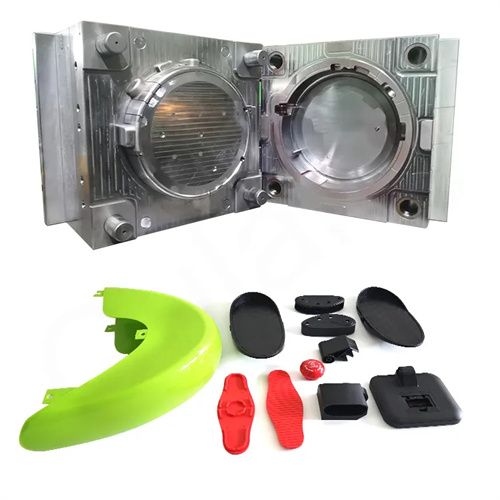Injection molding material unsmooth and solutions
Unsmooth material feeding during injection molding is a common process problem in injection molding. It manifests as material bridging within the hopper, blockage in the barrel feed port, and uneven screw feeding. These problems directly lead to poor melt plasticization and unstable injection volume, which in turn causes defects such as part shortages, dimensional deviations, and weight fluctuations. Unsmooth material feeding not only affects product quality but also reduces production efficiency and increases material waste. Statistics show that production interruptions caused by such issues account for 20%-30% of downtime in injection molding plants. For example, when producing thin-walled PP parts, unsmooth material feeding can cause the screw to plasticize inconsistently, resulting in part thickness deviations exceeding ±0.1mm and, in severe cases, even complete material shortages and scrap. Therefore, analyzing the causes of unsmooth material feeding and implementing effective solutions are crucial to ensuring the continuity and stability of injection molding production.

Raw material characteristics are inherent factors contributing to poor material flow. The physical properties of different raw materials significantly impact feeding performance. Uneven raw material particle size can lead to poor material flow within the hopper. Large particles can easily form bridges at the hopper outlet, blocking the feed path. For example, when the particle size variation of PE particles exceeds 2mm, the incidence of bridging increases by over 50%. High hygroscopicity is also a significant factor. Materials like PA and PC readily absorb moisture from the air, causing the particles to become sticky and clumping together, making it difficult to feed smoothly. Experiments have shown that when the moisture content of PA66 exceeds 0.2%, the feed rate decreases by 30%-40%. Furthermore, the shape of the raw material can affect feeding. Flakes or fibers are more prone to tangling and accumulation than granules, while round granules offer the best flowability and smoothest feeding. Impurities in the raw material, such as dust and metal debris, can cause blockage at the bottom of the hopper, especially at narrow feed openings.

Improper equipment structure and parameter settings are external factors contributing to poor feeding. An improper hopper design can significantly impact feeding. A too-small hopper wall inclination (less than 60°) can cause raw materials to accumulate on the wall, creating dead corners. A too-small hopper outlet diameter can easily become clogged by large particles. Improper temperature control at the barrel inlet is also a key factor. Excessively high temperatures can cause raw materials to melt prematurely at the inlet, forming “weld blocks” that block the feed channel. Excessively low temperatures can lead to insufficient preheating of the raw materials, especially for high-melting-point plastics, increasing screw feeding resistance. A mismatch between the screw’s structural parameters and the raw material’s characteristics can also lead to feeding problems. For example, when processing glass-fiber-reinforced plastics using a conventional screw, fiber wear and entanglement can reduce feeding efficiency and result in uneven feeding. Furthermore, excessively high screw speeds can cause excessive shearing of the raw materials within the barrel, leading to localized overheating and bonding. While too low a speed can provide insufficient feeding force, slowing feeding.

Addressing raw material characteristics is fundamental to improving smooth material feeding. First, ensure uniform raw material particle size. Select granules with a particle size deviation within 1mm. Raw materials with uneven particle sizes should be screened to remove oversized or undersized particles. Hygroscopic raw materials require thorough drying and storage in sealed hoppers to prevent reabsorption of moisture. For example, drying PC raw materials at 120°C for 4-6 hours to reduce the moisture content to below 0.02% can significantly improve material feeding. For raw materials prone to sticking, a small amount of anti-sticking agent, such as zinc stearate, can be added to the hopper at a controlled level of 0.1%-0.3% to reduce interparticle adhesion. Raw materials must be properly protected during storage and transportation to prevent contamination. They should be filtered to remove dust and foreign matter before use. For flaky or fibrous raw materials, a stirring device can be installed at the bottom of the hopper to break up any bridging structures.

Equipment optimization and process adjustments are effective means of resolving material feeding issues. Hopper modifications can increase the inner wall angle to 65°-75° and polish it (Ra ≤ 0.8μm) to reduce friction between the raw material and the wall. A vibration device can be installed at the hopper outlet to prevent material bridging through high-frequency vibration (30-50Hz). The vibration intensity can be adjusted based on the raw material’s characteristics. The barrel feed inlet should be equipped with an independent temperature control system to maintain the temperature 10-20°C below the raw material’s glass transition temperature. For example, when processing PA6, the feed inlet temperature should be controlled at 50-60°C to prevent premature melting of the raw material. The screw should be selected to match the raw material. When processing glass fiber reinforced plastics, a barrier screw should be used to reduce fiber entanglement. When processing high-viscosity plastics, a tapered screw should be used to improve feeding capacity. Regarding process parameters, the screw speed should be appropriately reduced (typically 30-80 rpm) to avoid excessive shearing of the raw material. The back pressure should be increased to 5-10 MPa to compact the raw material and improve feeding uniformity. Through these measures, the defect rate caused by unsmooth material feeding can be reduced to below 5%, significantly improving production stability.
